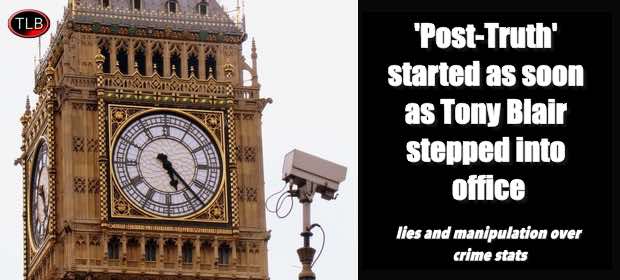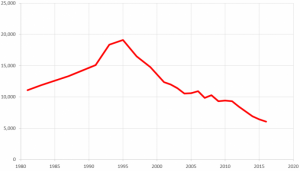
How The United Kingdom Became A Police State
This article will demonstrate how the United Kingdom has steadily become a police state over the past twenty years, weaponizing its institutions against the people and employing Orwellian techniques to stop the public from seeing the truth. It will demonstrate, contrary to official narratives, that both overall levels of crime and violent crime have been increasing, not decreasing, as the size of the state in the UK has gotten bigger. It will also expose how the Labour government under Tony Blair and Gordon Brown from 1997 to 2010, deliberately obscured real crime data with estimated crime rates based on survey data as opposed to the real numbers. I will demonstrate that, contrary to popular opinion perpetuated by progressive myths, life was much safer in Britain during the era of classical laissez-faire from the 1850s to 1911.
********
 In his 10 years in power from 1997 to 2007, Tony Blair (pictured) passed an astonishing 26,849 laws in total, an average of 2,663 per year or 7.5 a day. The Labour Party continued this madness under Gordon Brown who broke the record in 2008 by passing 2,823 new laws, a 6% increase on even his megalomaniac predecessor. In 2010, Labour’s last year in power before handing over the reigns to the Blairite social radical, David Cameron, there was a 54% surge in privacy cases brought against public bodies, and the Cabinet were refusing freedom of information requests at a rate of 51%. The vast number of new laws under Labour does not count the 2,100 new regulations the EU passed in 2006 alone, which apparently is average for them.
In his 10 years in power from 1997 to 2007, Tony Blair (pictured) passed an astonishing 26,849 laws in total, an average of 2,663 per year or 7.5 a day. The Labour Party continued this madness under Gordon Brown who broke the record in 2008 by passing 2,823 new laws, a 6% increase on even his megalomaniac predecessor. In 2010, Labour’s last year in power before handing over the reigns to the Blairite social radical, David Cameron, there was a 54% surge in privacy cases brought against public bodies, and the Cabinet were refusing freedom of information requests at a rate of 51%. The vast number of new laws under Labour does not count the 2,100 new regulations the EU passed in 2006 alone, which apparently is average for them.
Many of these vast changes under Blair and Brown were in the area of criminal law. By 2008, Labour had created more than 3,600 new offences. Many of these, naturally, were red-tape regulations. To give you an idea:
- Creating a nuclear explosion
- Selling types of flora and fauna not native to the UK, such as the grey squirrel, ruddy duck or Japanese knotweed
- To wilfully pretend to be a barrister or a traffic warden
- Disturbing a pack of eggs when instructed not to by an authorised officer
- Obstructing workers from carrying out repairs to the Dockland Light Railway
- Offering for sale a game bird killed on a Sunday or Christmas Day
- Allowing an unlicensed concert in a church hall or community centre
- A ship’s captain may end up in court if he or she carries grain without a copy of the International Grain Code on board
- Scallop fishing without the correct boat
- Breaking regulation number 10 of the 1998 Apple and Pear Grubbing Up Regulations
- Selling Polish Potatoes
There are many more. However, there were also some more serious breaches of civil liberty.
One common tactic of the Blair government was to use a moral panic to pass radical new legislation. For example, in 2006, he passed the Terrorism Act that overturned habeas corpus and gave the British police the right to detain anyone for any reason for 90 days. At the time, this got  widespread public support because of the recent 7/7 bombings in London (pictured). This means that, in the UK, the police can arrest you without you necessarily having committed a crime if they can brand your activities as “terrorist” or “extremist.” Although these laws were ostensibly brought about to combat Islamic terrorism, the ever-expanding definitions of “far right” and “extremist” demonstrate how they can be weaponised against the British people.
widespread public support because of the recent 7/7 bombings in London (pictured). This means that, in the UK, the police can arrest you without you necessarily having committed a crime if they can brand your activities as “terrorist” or “extremist.” Although these laws were ostensibly brought about to combat Islamic terrorism, the ever-expanding definitions of “far right” and “extremist” demonstrate how they can be weaponised against the British people.
Another area in which the Labour government used moral panic cynically to overturn longstanding common law principles was the murder of Stephen Lawrence, which they used to eliminate the double jeopardy rule and, as per the MacPherson report, to put an end to colour-blind policing.
Recently there have been an increased number of cases in which the British state has encroached on civil liberties in a near-openly tyrannical way. The Count Dankula case, for example, in which a man was arrested for “hate speech,” then tried and made to pay a fine for telling off-colour jokes about the Nazis on Youtube. Then there was the young woman who was found guilty of being “grossly offensive” for posting Snoop Dogg lyrics on her Instagram account. And, most recently, the political activist Tommy Robinson was arrested and tried in mere hours for recording outside a courtroom. In each of these cases, despite some protests against the legal rulings, the media broadly sided with the courts, citing the technicalities of the law – in the former two cases section 127 of the Communications Act 2003 (another Blair special) – and brand anyone who would protest “far right” or “extremist.”
“Gaslighting” is a word from the world of psychology; it is a technique of manipulation to achieve power. Here are eleven warning signs:
- They tell blatant lies.
- They deny they ever said something, even though you have proof.
- They use what is near and dear to you as ammunition.
- They wear you down over time.
- Their actions do not match their words.
- They throw in positive reinforcement to confuse you.
- They know confusion weakens people.
- They project.
- They try to align people against you.
- They tell you or others that you are crazy.
- They tell you everyone else is a liar.
The British state has become increasingly Orwellian in its gaslighting of the British public since at least 1997 with near-total complicity from the media. In a recent article for Quillette, I argued that this has been the case in both Britain and the USA for years.
This has especially been the case in the area of crime. During a period in which both the Labour Party and the Conservative Party have become increasingly statist and interventionist on both an economic and civil level, we have been continually told that one of the positive effects of ever-increasing government control is that society is becoming more peaceful. This is the narrative, for example, of Steven Pinker’s The Better Angels of Our Nature: Why Violence Has Declined. In 2005, The Guardian told us that since 1995, overall crime had decreased by 44%. Almost a decade later the same publication wondered out loud what could be causing the continued decline in crime rates in the UK. And just a few years after that, they had changed their tune completely decrying sudden increases in violent crime and blaming this on cuts in police numbers. In the first few months of 2018, the shocking increases in instances of violent crime in Sadiq Khan’s London, which in the past year has seen rises of 31.3% in knife crime, 78% in acid attacks, 70% in youth homicides, 33.4% in robberies, 18.7% in burglaries, 33.9% in theft and 30% in child sex crime. But this story told by The Guardian – of a general trend down in crime over the past twenty years followed by a sudden and inexplicable spike – is simply not true, as I will demonstrate in this paper.
In 1997, Tony Blair famously ran on a platform of being ‘tough on crime, tough on the causes of crime’. Unfortunately for him, the reality of empirical crime data had stubbornly refused to comply with his anointed vision through his first years in power. “New Labour” were famous for the efficiency of their propaganda machine. American readers will no doubt be aware of Mr. Blair’s complicity in making exaggerated claims about Saddam Hussein’s “weapons of mass destruction” in the run up to the war in Iraq, but few readers – British, American, or otherwise – will know that the Blair government was also lying about the extent of crime in Britain. The Labour Party, who were so much about media perceptions and political spin, needed to find a way to show on paper that their “tough on crime, tough on the causes of crime” agenda was making good on its promise. So, in 2003, Tony Blair permanently changed the way crime is reported in the UK by introducing the National Crime Recording Standard (NCRS). Up until that point, crime in the UK was reported using hard data drawn from actual arrests and convictions from the police. However, from that point onwards, the official statistics were to be drawn from the British Crime Survey which estimates crime based on a survey of 50,000 people aged 16 or over. This works much like how television companies produce estimates for their show ratings. So that means that the statistics you see quoted in newspapers like The Guardian are not hard figures, but estimates drawn from surveys. Whatever the merits of this method, it produced a graph for the Blair government that looked like this:

This change ostensibly came about because – as part of the “tough on the causes of crime” part of their pledge, Labour wanted to count victims as opposed to the total number of offenders. Of course, this takes a huge number of crimes out of the data. For example, as it was introduced in 2003, because only over 16-year olds could be interviewed, crimes against minors were not registered in the official statistics. Also, because interviews had to take place in private properties, street crime habitually would not show up in these numbers. Of course, so-called “victimless” crimes – fraud or online crime – do not show up in this data either. Once you start to account for some of these caveats, it becomes more obvious why this extraordinary change in methodology would produce a downwards trend in the data. In fact, it was explicitly designed so that, because of these changes, it could not be compared with numbers before 2002.
In 2007, Ken Pease and Graham Farrell estimated that the survey data could be underestimating violent crime by as much as 82%, with the real number of victims closer to 4.4 million than 2.4 million. This massive margin of error means that the real crime rate becomes a matter for debate as opposed to a question of hard evidence. It seems to me that this was a deliberate choice by the Blair government. Hence, we now find the BBC wondering about what the real crime rate might be. And this is where the true extent of the Orwellian nightmare of the Blair and Gordon Brown years dawns: by making the crime rate an estimate, neither political party can reliably point to the facts, and it always becomes a question of one difficult-to-substantiate-narrative against another. “Post-truth” did not start with Vladimir Putin or Donald Trump – Tony Blair was doing it from the minute he stepped into office.
 However, real numbers of convicted offenders are still recorded and kept, although they are somewhat difficult to obtain. In the run-up to the 2010 British election, Conservative MP and Shadow Justice Secretary, Chris Grayling (pictured), requested the real numbers from the House of Commons library, which duly produced a series of independent reports. Incidentally, once the leader of the Tories, David Cameron, became prime minister in 2010, Chris Grayling became the Secretary for Justice and, to my knowledge, was happy to let this little detail slide and continue with the survey-based methodology. It is funny how power can change the incentives for action.
However, real numbers of convicted offenders are still recorded and kept, although they are somewhat difficult to obtain. In the run-up to the 2010 British election, Conservative MP and Shadow Justice Secretary, Chris Grayling (pictured), requested the real numbers from the House of Commons library, which duly produced a series of independent reports. Incidentally, once the leader of the Tories, David Cameron, became prime minister in 2010, Chris Grayling became the Secretary for Justice and, to my knowledge, was happy to let this little detail slide and continue with the survey-based methodology. It is funny how power can change the incentives for action.
In any case, the numbers that Grayling requested are damning for anyone who claims that either overall crime or violent crime decreased in the UK between 1997 and 2010.
The population of the UK was about 58 million people in 1997. In 2008, that had increased to 62 million, an increase of 6.87%. In that same period, male violent crime convictions in England and Wales increased by around 63.92% from 49,153 in 1997 to 80,574 in 2008. So violent crime convictions increased by more than ten times the growth of the population.
Increases like this can been seen across virtually every category of crime. Convictions for persons under 18, for example, increased by 60.18% from 12,806 in 1997 to 20,513 in 2008, in keeping with the average increase in violent crime, this is ten times the rate of population growth in the same period. Knife crime practically doubled during the Blair years, from 3,360 offenders in 1997 to 6,368 in 2008. In 1998 there were 5,542 robberies, in 2008 there were 8,475. From the year 2000 to 2008, the total number of arrests for any offence went up from 1.2 million to 1.4 million, an increase of about 17%.
For the claim to be true that violent crime went down 44% during the 2000s in the UK, it would have to be at a time when violent crime convictions went up 64%. For the claim to be true that overall crime went down in from 1997 to 2008, it would have to be at a time when overall convictions for crime went up by 17%. Both claims seem extraordinary: how could there be a rise in convictions without a corresponding increase in crime? The methodology that measures victims through estimates from survey data clearly is not getting this correct.
If we use recorded convictions in this way, as opposed to estimates, we can make meaningful comparisons to the past as Peter Hitchens does in The Abolition of Liberty. As we have seen, the total number of convictions in England and Wales for 2008 was around 1.47 million for a population of 62 million people, around 2.25% of the population. According to Hitchens the comparable number in 1861 at the height of laissez-faire was 88,000 for a population of 20,066,224, or around 0.44% of the population. In 1911, before Leviathan and the welfare state had really had a chance to grow, the number was 97,000 for a population of 36,075,269, or around 0.27% of the population. The claim that crime has risen because of government cuts to the numbers of police also cannot stand since in 1911 there were 51,203 officers whereas by 2009 there were 144,353 officers. The increase in police officers from 1911 to 2009 therefore is 181.92% compared with an increase of 71.86% in total population. So the size of the repressive apparatuses of the state have increased greatly, and with it the total number of criminals.
It is clear that with less personal freedom and a bigger and more invasive state comes less personal responsibility and greater lawlessness. It is also clear that, as the British state has become more top-down in orientation than in its common-law past, it has levied increased coercive legislative power against the British people it supposedly serves. The state is now behaving in an openly Orwellian manner with near-explicit contempt for the public.
************
Original article
Please read the Mises version for the list of citations
ER recommends other articles by Zerohedge and Mises Institute
About the author
Neema Parvini is a Senior Lecturer in English at the University of Surrey




